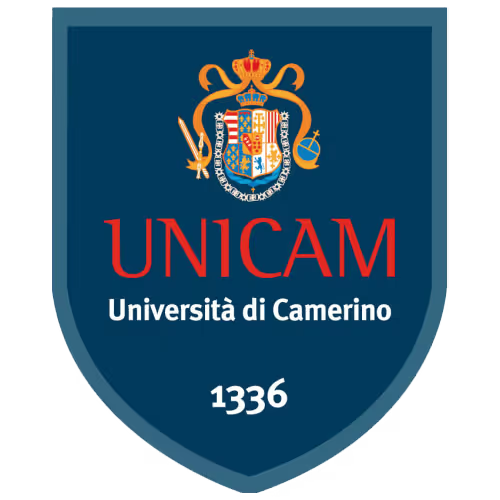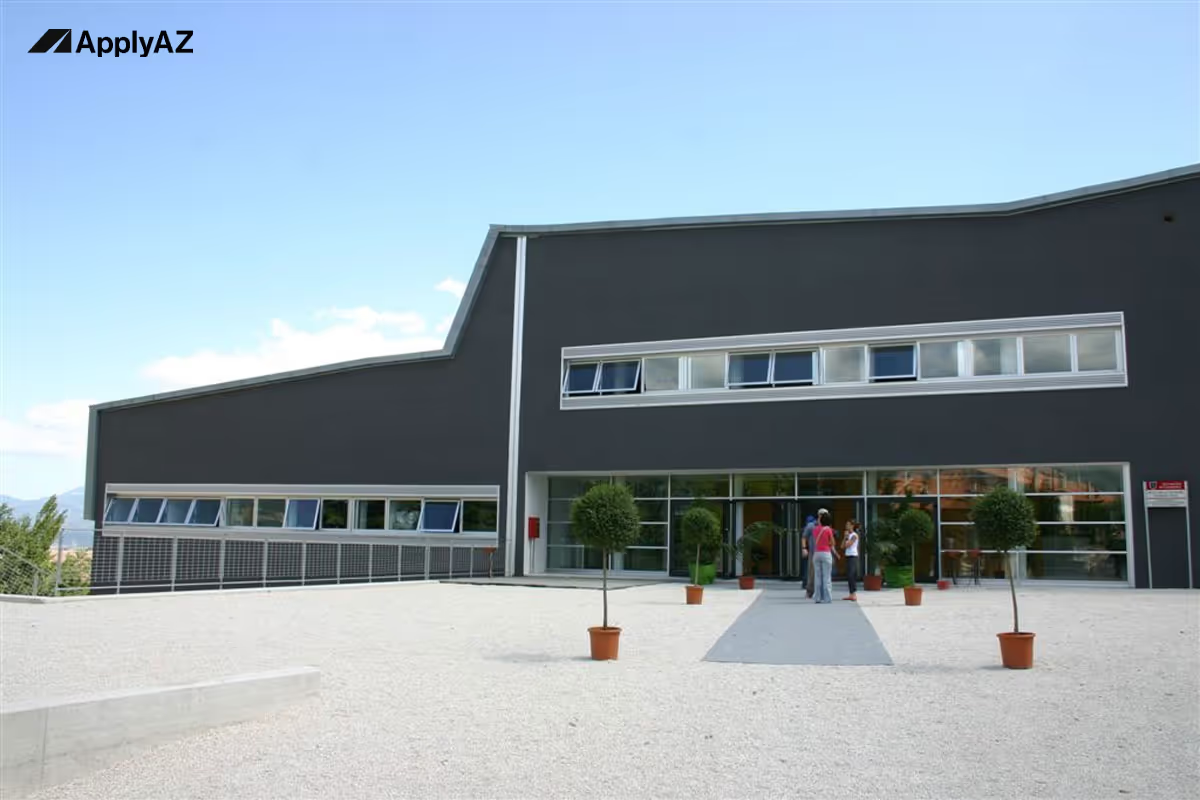Heading
Heading








University of Camerino
A historic campus with modern research ambitions
Founded in 1336, the University of Camerino is one of Europe’s oldest public institutions. Despite its age, the university keeps pace with global innovation through five specialised schools: Architecture and Design, Biosciences and Veterinary Medicine, Law, Pharmacy, and Science and Technology. International rankings often highlight its research impact in chemistry and computer science, while the teaching environment earns high student‑satisfaction scores. Several master’s degrees now run fully in English, adding to the growing list of English‑taught programs in Italy and giving you the chance to study in Italy in English while paying regulated state fees.
Academic highlights
- Chemistry and Advanced Materials laboratories recognised by European research councils.
- Computer Science department leading Horizon projects on cybersecurity and artificial intelligence.
- Veterinary Medicine hospital offering hands‑on clinical rotations with small and large animals.
- Architecture school nestled in a UNESCO‑listed region, perfect for heritage‑restoration studies.
Living and learning in Camerino
Camerino is a small medieval town in the Marche region. Its compact size means lecture halls, dorms, cafés, and sports facilities all sit within a fifteen‑minute walk. With roughly 6,000 residents and 8,000 students, the local economy welcomes student life. Rents for shared flats average €200–€250 per month, and university cafeterias serve balanced meals for under €4. The Apennine setting keeps summers warm (about 28 °C) and winters cool but sunny (around 4 °C), ideal for hiking or skiing between study blocks. Buses link the town centre to railway hubs, and a discounted student pass covers regional travel.
Cultural events—classical concerts in Renaissance halls, food festivals celebrating truffles and olives, and weekend language exchanges—make it easy to integrate. Because classes are in English, international students quickly build mixed friendship groups, then pick up conversational Italian during everyday errands.
Job prospects and internships
While Camerino itself is small, its network of partnerships spans the Marche manufacturing belt and national research centres. Key sectors include:
- Pharmaceuticals and biotech – regional plants host internships for pharmacy and chemistry students.
- Agri‑food technology – nearby companies refine food‑quality analytics and sustainable packaging.
- Advanced manufacturing – robotics and composite‑material firms collaborate with engineering labs on Industry 4.0 projects.
- Digital services – local start‑ups use cloud and AI solutions, offering roles for computer‑science graduates.
Internship agreements allow you to earn thesis credits and apply classroom theory to real problems. Many positions accept English as the working language and pay modest stipends, easing living costs. After graduation, alumni find roles across Italy and wider Europe, helped by the university’s career office and Erasmus+ research networks.
Funding and scholarships
Being part of public Italian universities, Camerino keeps tuition predictable—generally €900–€2,000 a year depending on household income. International applicants can compete for the DSU grant, which may waive fees entirely, provide rent support, and add a yearly stipend of up to €7,000. Merit scholarships for high GPA or language scores further reduce expenses, making the overall package competitive with tuition‑free universities Italy references.
Why choose Camerino
- Intimate learning: small cohorts mean professors know your name and guide your research closely.
- Cost advantage: affordable housing, DSU grant opportunities, and low campus fees.
- Research access: modern labs open to master’s students from the first semester.
- Lifestyle balance: safe town, clean air, mountain sports, and rich cultural heritage.
Finish your classes on Friday, hike the Sibillini peaks on Saturday, and present your polymer‑science poster at a European conference on Monday—that’s the Camerino rhythm.
In two minutes we’ll confirm whether you meet the basic entry rules for tuition-free, English-taught degrees in Italy. We’ll then quickly see if we still have space for you this month. If so, you’ll get a personalised offer. Accept it, and our experts hand-craft a shortlist of majors that fit your grades, goals, and career plans. Upload your documents once; we submit every university and scholarship application, line up multiple admission letters, and guide you through the visa process—backed by our admission-and-scholarship guarantee.
Geoenvironmental Resources and Risks (LM‑74) at University of Camerino
1. Global challenge, Italian solution
From landslides to lithium, the twenty‑first century demands geoscientists who manage Earth’s resources while reducing environmental risks. English‑taught programs in Italy answer that need, offering continental field sites and regulated tuition. When you choose to study in Italy in English on the Geoenvironmental Resources and Risks LM‑74, you gain core science, policy insight, and modern tech within the budget frame of public Italian universities. Adding the DSU grant or other scholarships for international students in Italy can push net costs toward figures seen at some tuition‑free universities Italy highlights.
This two‑year master’s (120 ECTS) equips you to quantify hazards, audit mineral deposits, and build decision tools that balance extraction with conservation. The curriculum marries geology, hydrology, geomatics, and risk economics, then tests them on real projects fed by industry and EU research calls. Small classes mean professors walk you through field logs, GIS layers, and lab spectra personally, ensuring clear progress.
2. Programme structure: building competence from core to capstone
Year 1 – scientific foundations and tool mastery
- Advanced Geomorphology (9 ECTS) – slope dynamics, fluvial processes, coastal retreat; weekly labs analyse LiDAR‑derived DEMs.
- Sedimentary and Structural Geology (9 ECTS) – basin analysis, fault kinematics, plate‑boundary systems; field notebooks record bedding attitudes and fracture sets.
- Hydrogeology and Groundwater Modelling (6 ECTS) – Darcy’s law, flow nets, MODFLOW simulations for aquifer management.
- Geochemistry of Ore and Water Systems (6 ECTS) – trace‑metal behaviour, isotopic tracers, ICP‑MS data handling.
- GIS and Remote Sensing (6 ECTS) – QGIS techniques, satellite imagery, geomatics coding in Python.
- Elective A (6 ECTS) – choose Applied Geophysics, Environmental Microbiology, or Sustainable Mining Technologies.
Year 2 – integration, policy, and research
- Natural Hazard Assessment (6 ECTS) – probabilistic seismic hazard, landslide susceptibility, volcanic alert levels.
- Environmental Impact and Risk Economics (6 ECTS) – cost–benefit, insurance modelling, EU environmental directives.
- Georesource Management and Circular Economy (6 ECTS) – critical raw materials, secondary‑resource recovery, life‑cycle metrics.
- Field Mapping Camp (6 ECTS) – ten‑day immersion measuring stratigraphy, landslide scars, and hydrochemical springs; deliver a GIS‑based map and report.
- Research Internship (18 ECTS) – 450‑hour placement in industry or research lab; tasks feed directly into thesis.
- Elective B (6 ECTS) – options include Coastal Geo‑hazards, Urban Geology, or Climate‑change Modelling.
- Master’s Thesis (30 ECTS) – original study such as landslide early‑warning sensors, rare‑earth‑element resource appraisal, or aquifer vulnerability mapping.
3. Pedagogic model: flipped, field‑centred, feedback‑rich
Professors release micro‑lectures and papers one week ahead. Classroom time pivots to data interpretation, GPS troubleshooting, and debate on policy trade‑offs. Every module follows a four‑week sprint:
- Plan – define learning objectives and deliverables.
- Execute – conduct labs, code scripts, or gather field samples.
- Demo – present maps, models, or air‑photos in five‑minute sessions.
- Retrospect – review errors and set new strategies.
Instructions stay under 80 words, ensuring clarity for CEFR B2 students.
4. Research and technical infrastructure
- LiDAR and Drone Unit – UAVs with RGB and multispectral payloads; rapid hill‑shade modelling.
- Geophysical Kit – GPR antennas, resistivity cables, and seismic refraction lines for subsurface imaging.
- Stable‑Isotope Lab – mass spectrometers for δ¹⁸O, δD, and δ¹³C, useful in tracing groundwater recharge.
- Mineral‑Analysis Suite – XRF, SEM‑EDS, and XRD instruments for grade assessment.
- High‑Performance Computing Cluster – 10 000 CPU cores plus GPUs; runs finite‑element landslide simulators, flood models, and machine‑learning hazard classifiers.
- GIS Research Room – dual‑screen workstations, large plotters, and open‑source tool stacks.
Small student numbers mean instrument booking rarely exceeds 48 hours.
5. Fieldwork intensity: from outcrop to policy brief
Geoenvironmental science demands boots on the ground. The department schedules:
- Weekend reconnaissance trips to carbonate cliffs and active faults.
- Water‑quality transects sampling springs, wells, and rivers; lab sessions analyse conductivity, nitrate, and metal loads.
- Ore‑deposit surveys mapping structural controls and collecting hand specimens.
- Urban hazard walks measuring building vulnerability for seismic retrofitting.
Field tasks culminate in professional‑style reports aligned with international standards (e.g., SANS 10160, ISO 14001).
6. Internship pathways and industrial ties
The 18‑credit internship embeds you in:
Host TypeExample ProjectsTypical OutcomesEngineering consultanciesLandslide‑risk zoning for road corridorsGIS parcel maps and risk indicesMining firmsResource estimate for critical metalsDrill‑core logging and reserve modelEnvironmental agenciesGroundwater nitrate mitigation planCalibrated MODFLOW model and policy memoInsurance and risk‑management companiesCat‑bond parametric triggers for seismic eventsHazard curves and payout tables
Mentors supervise weekly logs and co‑author conference posters, giving early citations.
7. Funding profile: DSU grant plus layered support
DSU grant
- Benefits: tuition waiver, residence subsidy, meal vouchers, yearly stipend up to €7 000.
- Eligibility: household income below set thresholds; EU and non‑EU equally considered.
- Renewal: earn at least 30 ECTS with satisfactory grades.
Extra scholarships for international students in Italy
- Merit fee reductions for GPA ≥ 3.5/4.
- Teaching assistantships in GIS or geochemistry labs (150 paid hours).
- Erasmus+ mobility bursaries for terms in Norway, Spain, or Germany.
- Industry‑sponsored awards targeting critical‑raw‑material research.
Combine these sources, and costs may approximate those at tuition‑free universities Italy references, yet you access modern kit and tight mentoring.
8. Graduate outcomes: numbers, roles, and recognition
A recent survey shows 92 percent employment or PhD placement within six months. Alumni occupy:
- Geo‑risk analyst in global reinsurance firms, modelling earthquake loss.
- Hydrogeologist designing remediation for industrial brownfields.
- Exploration geologist evaluating battery‑metal prospects.
- GIS specialist at UN disaster‑response units, drafting landslide alerts.
- Doctoral researcher studying climate‑induced slope failures.
Employers praise graduates’ mixture of rigorous field habit, data‑crunching skill, and fluent English reporting—direct outputs of studying in Italy in English.
9. Admissions framework and ApplyAZ support
- Bachelor’s in geology, civil/environmental engineering, geography, or environmental science (180 ECTS).
- English proof – IELTS 6.5, TOEFL iBT 90, or English‑medium degree.
- Prerequisite modules – geology basics, geomatics, maths, and physics.
- Online interview – 20 minutes evaluating field experience, GIS familiarity, and motivation.
10. Key programme advantages distilled
- Entirely English‑taught inside a cost‑controlled Italian public system.
- Balanced curriculum spanning geology, hydrology, GIS, and risk economics.
- Access to drone, LiDAR, and high‑performance modelling tools from semester 1.
- DSU grant plus supplementary scholarships trim living costs dramatically.
- High placement in geotech, environmental consulting, and research doctorates.
- Small class sizes ensure one‑on‑one guidance and fast feedback cycles.
- Field‑centric ethos crafts professionals comfortable on outcrop, in lab, and behind code.
This blend marks Camerino’s LM‑74 as a top contender among English‑taught programs in Italy for geo‑minded students seeking value and impact.
Ready for this programme?
If you qualify and we still have a spot this month, we’ll reserve your place with ApplyAZ. Our team will tailor a set of best-fit majors—including this course—and handle every form and deadline for you. One upload, many applications, guaranteed offers, DSU grant support, and visa coaching: that’s the ApplyAZ promise. Start now and secure your spot before this month’s intake fills up.

They Began right where you are










